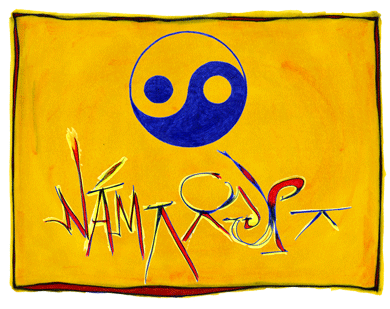
The Second Lesson
Dvi Nāma Kim? What is Two?
What two concepts, when used to see things to their root with penetrating knowledge, and to understand them in their broadest limits, such that their disgusting nature is seen as it really is and one has released them in their entirety, can bring one to the uttermost freedom of detachment?
Nama = Name and Rupa = Form.
Nama. In your thinking use 'name'. That is the term with the best resonance in your mind. It is very much like our understanding of perception. It is the having been identified state of a form.
Rupa. Form, shape, substance, material, entity; nature as object, of the wave striking the sense organs. Better "form" than "shape" because sounds and thoughts, which have no shape, have form. It is the having come into a recognizable (nameable) form of light. The literal meaning of 'rupa' is light. That is the furthest-reduced state of matter. So there will be confusion when you read about the a-rupa (non-rupa) states. But that ideas are included in forms is clear when ideas can be seen as a series of identified forms. Emotions as series of ideas. Sounds are 'wave-form'.
Name and Form, Phe-Nomenon, Mind and Matter; the mental and the material; identity/entity
There is Nama and there is Rupa.
Nama encompasses everything, including Rupa;
Rupa encompasses everything, including Nama.
[The Buddha is Speaking] "'What is there right here in front of our eyes that gives rise to Name and Form?'
"Studiously examining the etiology of the matter Beggars, I could see: 'Where we have Individualized Consciousness, there also we have Name and Form.' Individualized Consciousness, exists here in front of our eyes and we can see for ourselves that Individualized Consciousness, is necessary for the existence of Name and Form. Without Individualized Consciousness, we would have no Name and Form."
"But what can we do to escape Individualized Consciousness?"
"Then this thought occurred to me: 'What is there right here in front of our eyes that gives rise to Individualized Consciousness?'"
"Studiously examining the etiology of the matter, Beggars, I could see: 'Where we have Name and Form, there also we have Individualized Consciousness.' Name and Form exists here in front of our eyes and we can see for ourselves that Name and Form is necessary for the existence of Individualized Consciousness. Without Name and Form we would have no Individualized Consciousness."
"This Individualized Consciousness, this knowing as an individual is delimited by Name and Form. To have Consciousness as an individual it is necessary to have Name and Form and it is not necessary to have anything more than Name and Form to have Consciousness as an individual.
It is only to this point that there is that which is understood to be
"a being,"
"a being born"
"aging, sickness and death,
grief and lamentation,
pain and misery,
and despair."
"What I saw, Beggars, was that to have consciousness as an individual it is necessary to have Name and Form;"
"To have Name and Form it is necessary to have consciousness as an individual..."
The Lost Citadel Sanyutta Nikaya II, #65: Nagaram
One, of many yarns accompanying "The 10 Questions", this one from The Minor Readings, translated by Bhikkhu Nanamoli, Pāḷi Text Society, London: 1960, is excerpted here [a good example of one style of Sutta transmission]:
"Now the turn has come for the commentary on the Boy's Questions that begins with 'One is what?' We shall give a commentary after telling the Need Arisen [for their utterance] . . .
"The Need Arisen was this. The Blessed One had a great disciple called Sopaka. That venerable one developed final knowledge [Aññā] at the age of only seven years from his birth. The Blessed One wanted to allow his Full Admission [to the Community] by the method of getting him to answer questions, and, seeing his ability to answer questions in the sense that he, the questioner himself, intended, he put the questions beginning with 'One is what?' The Boy answered and satisfied the Blessed One with his answers. And that was the venerable one's Full Admission. This was the need arisen.
Rightness. [Sammattam = a High Measure of Madness, meaning seeing things as they really are, considered mad by the world. Most translators understanding this to mean mastery of the Eightfold Path. See Glossology: Sammatta.
![]() — p.p.
— p.p.
And here is the way the question in full is to be understood as translated by Bhikkhu Nanamoli: "...this is said by the Blessed One: 'Bhikkhus, when a bhikkhu becomes completely dispassionate towards one [two, etc.] idea, when his lust for it completely fades away, when he is completely liberated from it, when he sees completely the ending of it, then he is one who, after attaining rightness, makes an end of suffering here and now.
References:
Glossology: Nama/Rupa
Dhammatalk: What is 2?
Sopāka
